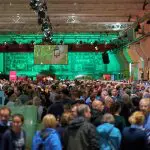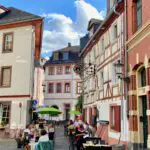1 When to visit German vineyards?
The short answer: visit German wine regions in March, April, May, June, September, October, December. The period Christmas to end of January is a no-go.

The long answer: Every season has its merits – and the German vineyards feature the beauty of Spring, Summer, Autumn and Winter very distinctively. Spring bud-break, summer sunshine, the colours of autumn and the ice crystals in winter make for wonderful visiting experiences. But spring offers the opportunity to get a taste of the lastest vintage, as most wineries will be publicly releasing their estate and village wines in April, May and June.

Autumn on the other hand provides a promise of the wines to come, providing visitors the chance to witness harvest action in the vineyards throughout September and October.

Which would be travel dates to avoid then? Many wineries and touristic sites will close for seasonal breaks from December 24 to mid of January… and also February tends to be rather difficult. Better skip these months.

2 Which German wine region(s) to visit?
The short answer: Set up basecamp in Germany’s wine capital Mainz and visit Rheingau for the classics, Rheinhessen for the dynamics, Mittelrhein for the romantics.
The long answer: Again there is no straightforward answer to the question which of the 13 Germany wine regions you should visit.This may be much a function of your overall itinerary through Germany or your preference in wine styles and varietals. Here are some pointers: If you like Riesling, stay rather north, and visit Rheingau, Mosel, and Mittelrhein. If you prefer pinot varietals such as Pinot Noir, Gris, Blanc or Chardonnay, stay south and visit Rheinhessen, Pfalz and Baden. (Find more detailed profiles of german wine regions here)
If you haven’t been in Germany on a wine vacation before, do Rheingau for its wine soaked history and culture; plus its geography and layout is textbook for scholars of cool climate winemaking. Rheingau is very accessible from Frankfurt.
In any case setting up in Mainz, just west of Frankfurt, will give you rather easy day-trip access to a number of wine regions, such as Rheingau, Rheinhessen, Nahe, Mittelrhein and Mosel.

3 How to travel German wine country?
The short answer: take the train and combine your stay with the services of a local tour guide.
The long answer: a great many wine villages are connected to the public train system run by Deutsche Bahn DB. The free-of-charge mobile app by DB is available in english and provides both, the schedules and tickets. Many more touristic locations offer rental bikes.
The alternative, a rental car, will require the driver to either pass on tasting or spit during the tastings. The legally allowed alcohol level is 0.5 per thousand, but a level of 0.3 per thousand will suffice to get a driver into serious trouble in case of a traffic incident.
Opt for a licensed (!) local driver guide instead, who will not only show you around the wine country, but will also help you understand the wine culture and history.
At BottleStops we will be delighted to help you with your travel planning. Reach out to get support for a detailed itinerary design, free of charge if the wine tour is booked with BottleStops. Fees apply for an overall itinerary planning for your vacation in Germany.








